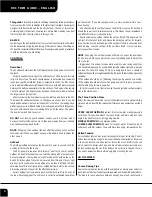
NORTHSTAR MANUAL
20
•
Your boat has normally self-bailing system. Water collected in the
deck will automatically drain out of the boat through hull
fittings.Please check hoses periodically.
9.4. STABILITY AND BUOYANCY
•
Any change in the disposition of the masses aboard (for example
the addition of a fishing tower, a radar, a stowing mast, change of
engine, etc.) may significantly affect the stability, trim and
performance of the craft.
•
Bilge water should be kept to minimum.
•
Stability is reduced by any weight added high up.
•
In rough weather, hatches, lockers and doorways should be closed
to minimize the risk of flooding.
•
Stability may be reduced when towing or lifting heavy weights
using a davit or boom.
•
Floatation in your boats hull.
•
Air tanks shall not be punctured.
•
Breaking waves are a serious stability hazard.
9.5. WEATHER
You should never leave the dock without first checking the local weather
forecast. You can get the weather information from the TV, radio, local,
newspaper, on-line, or from one of the weather channels.
At certain times of the year weather can change rapidly and you should
continually keep a "weather eye" out. While you are out in a boat here are
a few signs you can look for that indicate an approaching weather change:
•
Weather changes generally come from the west. Scan the sky with
your weather eye, especially to the west.
•
Watch for cloud to build up, especially rapid vertically rising clouds.
•
Sudden drop in temperature.
•
Sudden change in wind direction and/or speed.
•
If you have a barometer on your boat, check it every 2 to 3 hours.
A rising barometer indicates fair weather and rise in wind velocity;
a falling barometer indicates stormy or rainy weather.
9.5.A. WHAT TO DO IN SEVERE WEATHER
•
Reduce speed, but keep just enough power to maintain headway.
•
Put on your PFDs.
•
Turn on running (navigation) lights.
•
Head for nearest shore that is safe to approach, if possible.
•
Head bow of boat into the waves at about a 45-degree angle.
•
Keep bilges free of water.
•
Seat passengers on bottom of boat near centerline.
•
If your engine fails, trail a sea anchor on a line from the bow to
keep the boat headed into the waves. A bucket will work as a sea
anchor in an emergency.
•
Anchor the boat if necessary.
Summary of Contents for 265 WA -
Page 1: ...265 WA ENGLISH ...
Page 2: ......
Page 9: ...NORTHSTAR MANUAL 6 2 3 CE CERTIFICATE ...
Page 14: ...NORTHSTAR MANUAL 11 MAINTENANCE LOG DATE HOURS MAINTENANCE PERFORMED BY WHO ...
Page 15: ...NORTHSTAR MANUAL 12 ...
Page 16: ......
Page 17: ...englısh ...
Page 18: ......
Page 55: ......
Page 56: ......
















































